June 8, 2018
Air Date: June 8, 2018
FULL SHOW
SEGMENTS
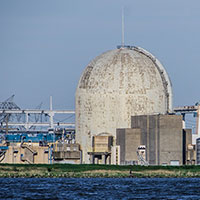
Zero Carbon Nuclear Boost For New Jersey
View the page for this story
New Jersey Governor Phil Murphy recently signed into law subsidies for two aging nuclear power plants. Some say the deal will help New Jersey meet its climate protection goals, but others have criticized the measure, citing safety concerns and a preference for renewables. Host Steve Curwood spoke with Vox Writer David Roberts. (08:06)
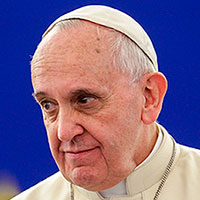
Beyond the Headlines
/ Peter DykstraView the page for this story
On this week’s Beyond the Headlines, Peter Dykstra and Steve Curwood discuss Pope Francis’s meeting with corporate leaders on climate change and the push to add a new and higher category to the Saffir-Simpson scale for hurricanes. In the history lesson, we look back at the fires of 1988 in Yellowstone National Park, and the recovery since that devastating event. (03:41)
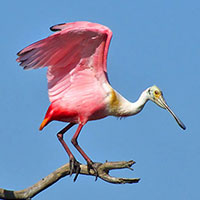
BirdNote®: Roseate Spoonbill: Hot Pink
/ Mary McCannView the page for this story
This aptly named bird has a unique bill and color that sets it apart from other wading birds. BirdNote’s Mary McCann reports. (02:03)

Toxic Black Hair Products
View the page for this story
Black women in America commonly use hair relaxers and leave-in conditioners to straighten and smooth their textured hair. But many of these products contain hormone-disrupting chemicals, which are associated with health problems such as early menarche, preterm birth, diabetes, and cancer. Dr. Tamarra James-Todd, an epidemiologist at the Harvard T.H. Chan School of Public Health, spoke with Host Steve Curwood. (14:54)
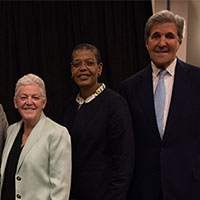
Former EPA Chief Gina McCarthy Launches Center for Climate, Health and the Environment At Harvard
View the page for this story
Recognizing the serious threats climate change poses to public health, the Harvard T.H. Chan School of Public Health recently launched C-CHANGE: the Center for Climate, Health, and the Global Environment. Former EPA Administrator Gina McCarthy is at the helm. Speakers at a launch event included John Holdren, former Science Advisor to President Obama; and John Kerry, former U.S. Secretary of State and a key architect of the Paris Agreement. Host Steve Curwood sat down with Gina McCarthy to discuss her vision and why she’s optimistic about the future. (17:09)
Show Credits and Funders
Show Transcript
HOST: Steve Curwood
GUESTS: David Roberts, Tamara James-Todd, Gina McCarthy
REPORTERS: Peter Dykstra, Mary McCann
[THEME]
CURWOOD: From Public Radio International -- this is Living on Earth.
[THEME]
CURWOOD: I'm Steve Curwood. Former Secretary of State and Paris Climate Agreement architect John Kerry speaks out.
KERRY: It’s near criminal in the level of negligence that it represents to have a president and an EPA director who are not just avoiding the realities of climate but who are avoiding all sense of responsibility to the future. Lives will be lost!
CURWOOD: Mr. Kerry spoke at the launch of a Harvard climate and health initiative now led by former EPA Administrator Gina McCarthy.
MCCARTHY: If you look at climate change through the lens of public health, then you can identify significant opportunities to make the world a healthier place, to protect our kids’ health today, while we look at how we create a more sustainable and just future.
CURWOOD: That and more this week on Living on Earth – Stick Around!
[NEWSBREAK MUSIC: Boards Of Canada “Zoetrope” from “In A Beautiful Place Out In The Country” (Warp Records 2000)]
[THEME]
Zero Carbon Nuclear Boost For New Jersey
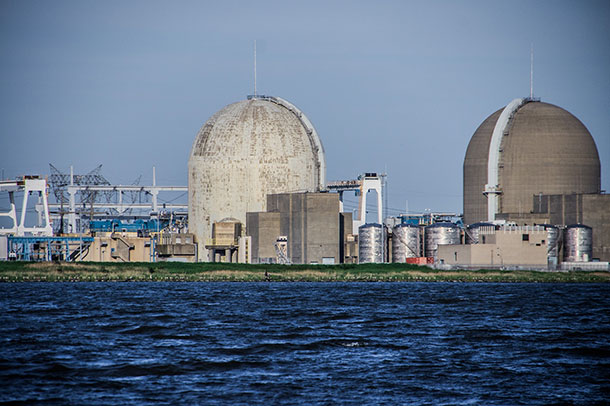
Salem Power Plant Reactors. (Photo: Peretz Partensky, Flickr CC BY-SA 2.0)
CURWOOD: From PRI, and the Jennifer and Ted Stanley Studios at the University of Massachusetts Boston, this is Living on Earth. I’m Steve Curwood. When it comes to the environment in New Jersey, there’s a new sheriff in town, and his name is Phil Murphy, though he’s actually the new Democratic governor. After eight years of environmental rollbacks under former Republican Governor Chris Christie, the Democrat is embracing greener policies. Mr. Murphy has signed bills to promote offshore wind and higher renewable portfolio standards for power companies. And probably the most controversial measure commits New Jersey rate payers to spending 300 million dollars a year to keep two aging, but carbon-free, nuclear power plants alive. We turn now to David Roberts, a writer for Vox -- welcome back to Living on Earth, David.
ROBERTS: Hey Steve, glad to be here.
CURWOOD: Hey, how integral is nuclear energy to New Jersey's economy right now?
ROBERTS: It's a huge deal right now. About 40 percent of the state's power comes from nuclear and the vast bulk of the rest, over 50 percent, comes from natural gas. So, you can sort of think of New Jersey's present grid as divided roughly 60/40 between natural gas and nukes. And, of course, renewables are in there but they're like two or three percent currently. So, you know, it's not that huge of a state and nuclear power plants are very large. So, two very large nuclear power plants in a mid-size state is a big chunk of the economy.
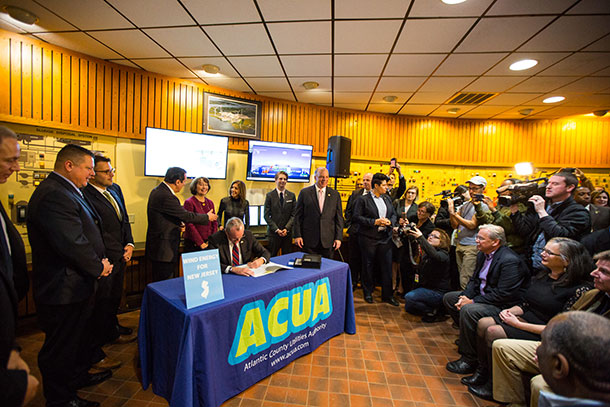
Governor Murphy has enacted a suite of legislation focused on renewable energy along with the nuclear deal. Here he is signing an executive order in January directing the New Jersey Board of Public Utilities to fully implement the Offshore Wind Economic Development Act. (Photo: Phil Murphy, Flickr CC BY-NC 2.0)
CURWOOD: Now, there are a number of environmental activists who are looking at renewable energy get heartburn over nuclear power. What are the arguments that they offer against a plan which is part of a low carbon plan?
ROBERTS: The fight over nuclear in New Jersey, and in New England and in the Northeastern states generally right now, is a fight over existing nuclear power plants. So, the question is: keep them open as long as possible, or shut them down? And so there's sort of a split in the environmental community right now between people who say, well, look if we've got these gigawatts of carbon-free electricity already being generated, maybe we should keep them because we're fighting climate change and carbon-free energy is at an absolute premium. And then on the other side are people who still oppose nuclear because the U.S. environmental movement has opposed nuclear. I mean, it was practically founded around opposing nuclear. So, the sort of habits and arguments and sentiments against nuclear are very, very, very deep-rooted in the environmental movement. And so they, you know, they don't like the waste, they don't like nuclear compared to renewables because it's big and centralized and the companies that own it tend to be highly concentrated and corrupt. And approaching this as a climate hawk -- if your main concern is carbon, then I just don't think you can afford to be cavalier about taking a bunch of zero carbon power off the grid, and I think that's where Murphy came down.
CURWOOD: So, the governor also signed legislation that increases the renewable energy portfolio standards and also encourages the use of offshore wind. How does this other set of bills fit into all these efforts?
ROBERTS: Right. It's a comprehensive, low-carbon approach. Technically, it's three pieces of legislation, three bills he's passing. One jacks up the state's renewable portfolio standard to 35 percent by 2040 and 50 percent by 2050, which is very ambitious -- I mean, relative to what other states have got. The second bill did a bunch to boost and make life easier for offshore wind, which is also picking up in that region. And then the third bill was the nuclear subsidies, $300 million dollars in ZECs that will go to nuclear plants.
CURWOOD: And for people who may not know or remember, a ZEC is a zero-emissions credit.
ROBERTS: Right.
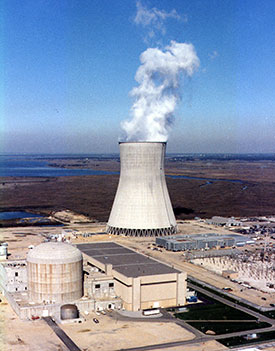
The Hope Creek Plant, one of the two being subsidized by New Jersey taxpayers under the new legislation. (Photo: Nuclear Regulatory Commission, Flickr CC BY-NC-ND 2.0)
CURWOOD: By the way, Governor Murphy has been positioning the state to be a leader in state level government action on climate change. When he came into office, the state rejoined RGGI -- Regional Greenhouse Gas Initiative -- which is a way that the power plant sector can trade emissions and lower emissions.
ROBERTS: Right. RGGI is great in a lot of ways, but let's just put it this way: the boost in renewable energy that will come from the renewable portfolio standard that Murphy just signed will do a lot more to reduce greenhouse gas emissions than RGGI. RGGI is a price on carbon, but as of right now at least it's a relatively mild price on carbon. So, New Jersey joining RGGI is great in that it sends a signal; it makes RGGI bigger and stronger. But in terms of the sort of direct significance to New Jersey's energy mix, these bills he just signed are a much bigger deal.
CURWOOD: So, give us a little bit of background information on the two nuclear plants that these subsidies will keep operating. They're called Salem and Hope Creek. What kind of safety issues if any are involved with these plants?
ROBERTS: I don't think either of them have safety issues over and above what you have to do at a nuclear plant to keep it safe. So, the reason they're closing is that nuclear plants are just getting killed on wholesale power markets. That's happening to nuclear plants everywhere because they're big and slow and expensive, and natural gas and renewables and efficiency are just outcompeting them. And so, nuclear is in a tricky situation. It doesn't want to necessarily throw its lot in with coal and try to get the same bailouts coal is getting, but on the other hand, in most states they're not compensated for the environmental benefits of their power. New Jersey is saying rather than some sort of generic measure to bail out big base load plants -- which is what the big base load plant owners want -- let's do something specifically for nuclear, specifically targeted at its environmental benefits.
CURWOOD: By the way, what are the other states, if any, that nuclear power is such a significant chunk of the energy portfolio, and what could they learn from what's going on in Jersey?
ROBERTS: Well, it's mostly in the Northeast, it's Northeast and mid-Atlantic states, and actually New Jersey should not get all the credit here. New York passed a similar support for its nuclear plants -- the exact same thing. They're the ones who sort of worked out and established the ZEC model. So, if anything, New Jersey is sort of taking a cue from New York here. But in terms of the other states, you know, every state like Connecticut, Pennsylvania, Delaware, they all have big chunks of their power coming from nuclear and they're all struggling with this issue. So, I don't know how far that will spread or how many of the states will take that up, but all of them are wrestling with this. It's very much on all their minds.
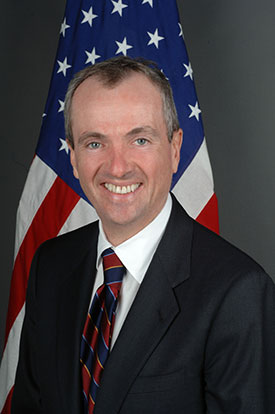
New Jersey Governor Phil Murphy. (Photo: By US Department of State via Wikimedia Commons)
CURWOOD: OK, time now to roll out the “David-Roberts-Official-Vox” crystal ball.
ROBERTS: Oh, good.
CURWOOD: OK. And tell us what role do you think nuclear energy will have in decarbonization plans over these coming decades.
ROBERTS: Goodness, that's a good question. I'll split my answer into two. I would say if current trends continue, existing nuclear plants will stay open longer and provide a foundation, and on top of that foundation, renewables will grow. Basically, no new nuclear plants are going to be proposed and built in the U.S. Probably, period. I will probably live to regret saying that. But the caveat is that they are at work on these whizbang new kinds of nuclear plants -- small, modular, they're sort of meltdown-proof, they don't produce any waste, they can’t -- you know, they’re perfectly safe, etcetera, etcetera. Then, I think, yes, nuclear will play a big role in the second half of the century.
CURWOOD: David Roberts is a writer at Vox. Thanks so much for taking the time with us today.
ROBERTS: Thanks a lot, Steve.
Related links:
- David Roberts on Nuclear Power
- More on the Nuclear Bill
- Phil Murphy’s actions on Renewables
[MUSIC: Richard Stoltzman, “Feast” on New York Skyline]
Beyond the Headlines
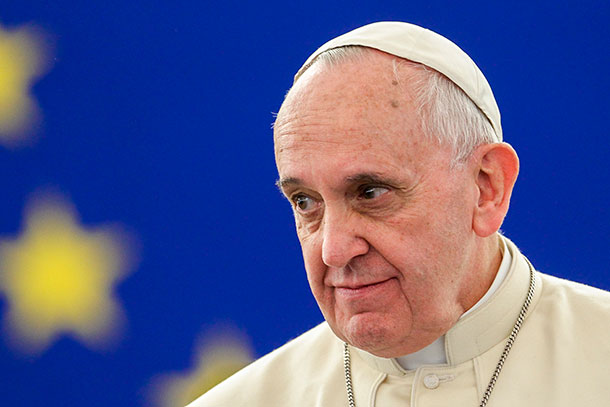
Pope Francis convened in June 2018 with leaders from BlackRock, BP and other companies to talk about climate change. (Photo: Martin Shulz, Flickr, CC BY-NC-ND 2.0)
CURWOOD: Let’s take a look Beyond the Headlines now with Peter Dysktra. Peter’s an editor with Environmental Health News; that’s ehn.org and dailyclimate.org. On the line now from Atlanta, Georgia -- hi there, Peter, what do you have for us today?
DYKSTRA: Hi Steve, you know it’s been awhile since we heard from Pope Francis. A few years ago, he seemed poised to be the first truly global leader taking a big stand on environment and particularly on climate change. He did that Papal Encyclical a few years ago on the environment. Something completely unprecedented for a leader of the Catholic church.
CURWOOD: So, what’s going on now?
DYKSTRA: Well, after Laudato Si, the encyclical, the Pope has come back, and he’s gathered a meeting of corporate leaders: British Petroleum -- or as it’s now known, BP -- , Black Rock and other companies coming together to talk about their global responsibility to address climate change.
CURWOOD: So, the Pope has gone to Wall Street, huh?
DYKSTRA: The Pope has gone to Wall Street; President Trump has gone to Wall Street but kind of in the opposite direction. This past week we also saw that there was an effort underway to have the Energy Department help prop up dying coal and nuclear power plants in this country. Plants that can no longer cut it on a free market basis, they’re dying off, they’re shutting down. The President and the Energy Department would like to keep them open. You’ll remember a few years ago there was that push under Obama to help clean energy. A lot of people said that we shouldn’t be backing winners and losers. Apparently now we’re just backing losers.
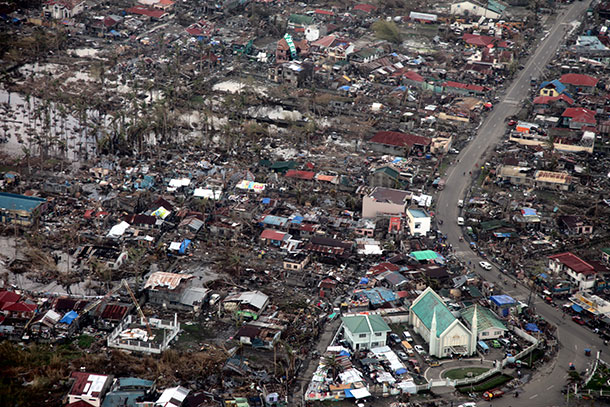
Increasing hurricane intensity has spurred some researchers to call for adding a “Category 6” to the Saffir-Simpson scale. During Typhoon Haiyan in 2013, for instance, wind speeds reached up to 195 miles an hour, causing wide-scale infrastructure damage and loss of life. (Photo: DFID (UK Department of International Development), Flickr, CC BY 2.0)
CURWOOD: [laughs] Hey, what else do you have for us today?
DYKSTRA: Something from Bob Berwyn who writes for our friends at InsideClimate News. Four climate scientists have published a paper in which they argue to expand the Saffir-Simpson scale -- that’s the scale by which we measure the intensity of hurricanes and typhoons. It goes up to Category 5, which is anything over 156 miles an hour in wind speed. But there have been storms in excess of 190 miles an hour that they say deserve Category 6.
CURWOOD: Oh, yeah, there’ve been some really big ones. I’m thinking of the one in the Philippines, Typhoon Haiyan, how fast was that one?
DYKSTRA: Right, Haiyan made it up to 195 miles an hour when it devastated several islands in the Philippines back in 2013.
CURWOOD: And, uh, you know I think they’ve changed the scale for heat waves in Australia -- now they use purple as the most extreme color on their chart.
DYKSTRA: The color purple’s been added to the heat chart in Australia because they’ve had such blazing summers. Of course, they’re going to get a break from that now since the Southern Hemisphere winter is beginning to set in. But still it’s a sign that everything everywhere is getting hotter and we need to be able to cope with it and address it.
CURWOOD: Let’s take a look into the history vaults right now. What do you have for us?
DYKSTRA: Let’s go back 30 years, June 14, 1988, Yellowstone National Park. A small wildfire broke out just outside the boundaries of the park in Montana. It combined with other wildfires within the park during a drought season, and Yellowstone National Park, through the summer of 1988, was ablaze. Eventually 36% of the park was touched by wildfire, a lot of it was devastated by wildfire, and it didn’t get put down until rain and snow came in mid-September three months later.
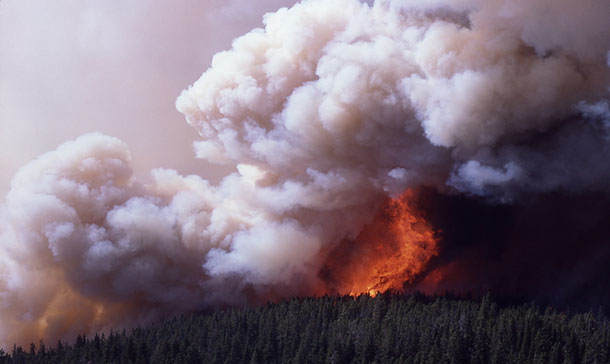
The 1988 fires in Yellowstone touched 36% of the park and 25,000 people helped put them out. (Photo: National Park Service, Wikimedia commons, public domain)
CURWOOD: I remember the pictures from there. It was just like, horrible. It was like a bomb had dropped. What’s it look like now?
DYKSTRA: The recovery has been spectacular; the natural recovery of Yellowstone has been something that was predicted by scientists. It’s come true, the park is back. It has always been one of America’s gems and it continues to be.
CURWOOD: Well thank you, Peter. Peter’s an editor with Environmental Health News; that’s ehn.org and dailyclimate.org. Talk to you again real soon.
DYKSTRA: Alright Steve, thanks a lot. Talk to you soon.
CURWOOD: And there’s more on these stories at our website, loe.org.
Related links:
- Axios: “Exclusive: Pope convenes Big Oil, investors to talk climate change”
- InsideClimate News: “Hurricane Season 2018: Experts Warn of Super Storms, Call for New Category 6”
- Yellowstone National Park: “1988 Fires”
[MUSIC: Earl Wild, “Fascinatin’ Rhythm]
CURWOOD: Just ahead -- how certain black hair products can make people sick. It’s all about endocrine-disrupting chemicals. That’s just ahead here on Living on Earth. Keep listening!
ANNOUNCER: Support for Living on Earth comes from the Gordon and Betty Moore Foundation, and from a friend of Sailors for the Sea, working with boaters to restore ocean health.
[CUTAWAY MUSIC]
CURWOOD: It’s Living on Earth, I’m Steve Curwood.
[MUSIC: BIRDNOTE® THEME]
BirdNote®: Roseate Spoonbill: Hot Pink
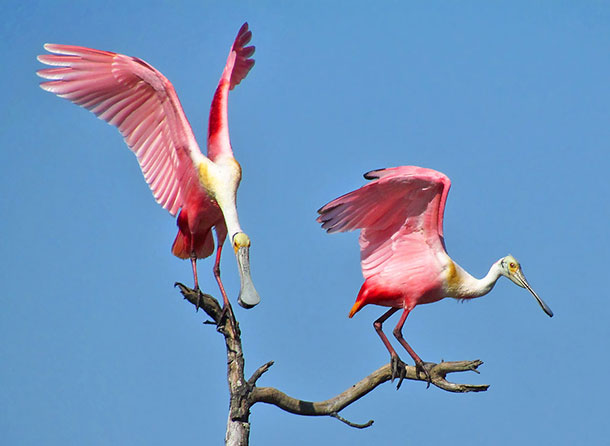
Roseate Spoonbills live year-round along the Gulf of Mexico and are the only Spoonbill species with a hot pink color. (Photo: Mike Hamilton ©)
CURWOOD: Birds have dominion over the skies, and you could argue they also reign supreme in the realm of beauty -- with flashy feathers in brilliant colors. And as Mary McCann of BirdNote® explains, some beautiful birds are also, well… a bit bizarre.
BirdNote®
Roseate Spoonbill – Hot Pink Along the Gulf of Mexico
MCCANN: Of all the bold colors nature has bestowed upon birds, somehow bright pink seems the most outrageous, the most surprising. And just about the hottest pink bird of all lives year round along the Gulf of Mexico -- the Roseate Spoonbill.
[Roseate Spoonbill call and bill snaps]
The Roseate Spoonbill is built like a large heron. It’s a tall, slender wading bird with a long neck. Adults have deep pink bodies, blazes of carmine red on the wings and necks, and a tail the color of orange sherbet.
So, the Roseate Spoonbill is gorgeous -- at least from the neck down. Its head is bizarre though: unfeathered bare skin, shading from yellowish to gray, with a very long bill that looks like it belongs to a different bird entirely, ending in a wide, flattened spoon shape. All set off by a ruby-red eye.
It feeds by wading through the shallows, head moving from side to side, bill in the water until sense organs inside it detect a small fish or crab, when the spoon snaps shut.
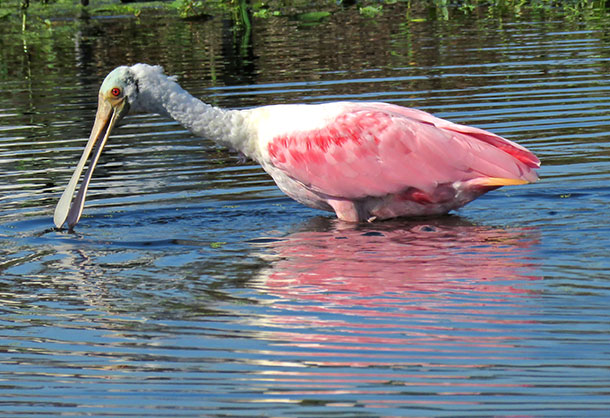
Sense organs inside a Spoonbill’s beak help the bird detect small fish and crabs. (Photo: Lee Ann Reiners ©)
This specialized way of feeding, known as tactolocation, is shared by all six of the world’s spoonbill species. Oddly, all the other species are feathered only in white and found in the Old World.
Which leaves just one on this side of the globe.
But -- it’s the hot pink one.
I’m Mary McCann.
###
Written by Bob Sundstrom
Bird sounds provided by The Macaulay Library of Natural Sounds at the Cornell Lab of Ornithology, Ithaca, New York. Roseate Spoonbill ambient [135411] M J Andersen and M J Fischer
Roseate Spoonbill call - http://www.xeno-canto.org/species/Platalea-ajaja -
Xeno-Canto [173887] recorded by Paul Marvin.
BirdNote's theme music was composed and played by Nancy Rumbel and John Kessler.
Producer: John Kessler
Executive Producer: Dominic Black
© 2005-2018 Tune In to Nature.org June 2018 Narrator: Mary McCann
https://www.birdnote.org/show/roseate-spoonbill
CURWOOD: For photos, wade on over to our website, loe.org.
Related link:
Listen on the BirdNote website
Toxic Black Hair Products
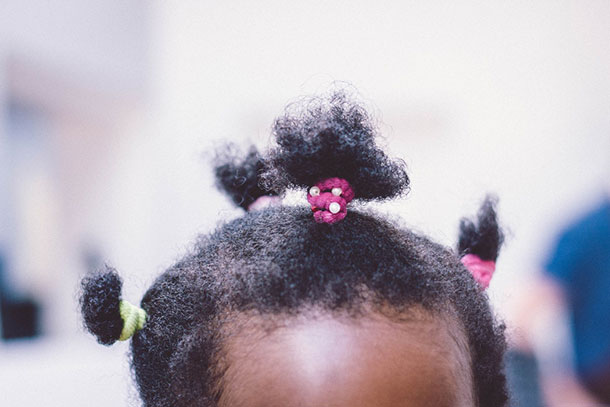
Dr. James-Todd says that as society moves away from white standards of beauty, more black people have come to embrace their natural hair. (Photo: Nina Strehl, Unsplash)
[CLIP FROM HAIR THE MUSICAL https://www.youtube.com/watch?v=w_zaSKZks1A]
“Darlin', give me a head with hair, long beautiful hair
Shining, gleaming, steaming, flaxen, waxen”
CURWOOD: Hair: you can style it just about any way you like – if you use enough heat or hair product. And if your hair reflects your African roots but you’d rather keep it straight and smooth, chances are you use a whole bunch of products including leave-in conditioners, root stimulators, and relaxers. But some of these products may be harmful to your health. The Silent Spring Institute measured concentrations of estrogen-mimickers and other chemicals that disrupt the hormone system in hair products marketed to black women. They tested 18 popular products and detected between 4 and 30 of these chemicals in each one, and worked with epidemiologist Tamarra James-Todd at the Harvard T.H. Chan School of Public Health. And she joins us now. Welcome to Living on Earth!
JAMES-TODD: Thank you so much for having me.
CURWOOD: So, talk to me about how diverse black women’s hair is. You know, as black people, we come in all kinds of shades; I imagine, the hair comes all kinds of different ways.
JAMES-TODD: Right. So, there are different textures and different grades of hair from relatively straight hair to very curly, sometimes called “kinky” hair, and they have different requirements. It's really dependent on the shape of the hair shaft, but that can cause people to need to use different types of products.
CURWOOD: And people often don't like the hair they have. If it's straight, they want it curly. If it's curly, they want it straight, huh?
JAMES-TODD: I think that would be universal for most women. [LAUGHS] Definitely. But certainly in the black community I think that there are some real issues around hair and part of that is kind of social and cultural issues regarding what is seen as beautiful, with straight long hair being kind of the stamp of beauty -- oftentimes in American culture particularly, in Western culture -- and so, people will do different things to try to adhere to that standard of beauty.
CURWOOD: So, what kinds of hair products do black women typically use?
JAMES-TODD: So, oftentimes when I'm asked this question and when I first started this line of work, the first thing that would come up is, oh, hair relaxers. And so, thinking about things that people use, you know, whether it's every few months or a couple of times a year to straighten their hair. But what I think is often forgotten is things that we use daily such as hair oils, moisturizers, lotions, leave-in conditioners, gels -- kind of, you name it, that's what people are using to get the different styles that they want.
CURWOOD: Or heat... I mean, as an African-American growing up, I saw women with these really hot combs and I have to laugh out loud at Alex Haley's Autobiography of Malcolm X where he has this scene that Malcolm X tries to straighten his hair and his head is on fire so he sticks his head in a toilet to cool it down.
JAMES-TODD: Yes, that scene, I think, many, many women and some men can identify with... pressing, those pressing combs. So, it's not just chemicals, but it's also physical changes that people will try to do or undertake.
CURWOOD: So, what got you first interested in studying the potential health effects of chemicals in black women's hair?
JAMES-TODD: So, when I was a master’s student at Boston University, there was an interesting study of magazine advertisements advertised to white women versus black women. And there was a Ladies Home Journal article where it had an ad for white women being marketed to, kind of, anti-aging cream containing hormones. And the other magazine, which was kind of featured in this particular study, was from Essence magazine, a magazine commonly marketed and read by black women, and it was advertising placenta. And it was something that I remember seeing when I'd walk into, you know, a black hair supply or hair care store, and seeing placenta and just wondering, what exactly is that for? Why are people using that? And around that same time, an issue of Time magazine had come out, kind of querying why were girls starting their periods earlier and earlier. And somehow that just kind of clicked for me. Is it possible that what is in some of these hair products around hormones and so on… is that part of the reason why we're seeing earlier periods, particularly in black girls, which at the time there was a very large study that had reported that 60 percent of black girls had reached their periods by age 12 compared to only 30 percent or so of white girls. So, as a master’s student, that piqued my interest.
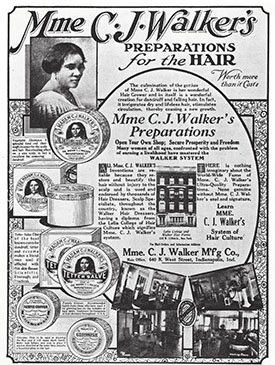
A 1917 Advertisement. Madam C. J. Walker, an entrepreneur and activist born in 1867, led the movement to create healthy hair care products designed specifically for black women. (Photo: Courtesy of Madam Walker Family Archives/A'Lelia Bundles)
CURWOOD: And the answer is?
JAMES-TODD: So, we did, in fact, do a study; as a doctoral student at Columbia University, I did a study called the Greater New York Hair Products Study where we did, in fact, go and we queried what types of hair products people are using. And we found that young girls who were using hair oils for a longer period of time and more frequently had a significantly higher risk of starting their periods earlier than girls who had never used hair oils. And you know, each year earlier that a girl starts her period, it’s an increased risk for developing breast cancer.
CURWOOD: So, I'm thinking that this is linked somehow to chemicals -- fancy name is endocrine disrupters -- hormone disrupters, chemicals that kind of mimic estrogen and other hormones. To what extent is this phenomenon linked to such chemicals, do you think?
JAMES-TODD: So, at the time we started looking at this because of another study that had come out of the small case series of four young African-American girls. They ranged in age from four months old to four years old, and they had all developed breast and pubic hair. So, incredibly young children…
CURWOOD: ...at four months?
JAMES-TODD: At four months old!
CURWOOD: … at four months!
JAMES-TODD: ...and interestingly enough, the pediatric endocrinologist that had seen these young girls asked the moms all sorts of questions about what products they were using, what they had been exposed to in the home. And the common thread he was finding was that all of the moms were using -- these were girls so they were all using hair oils and different types of care products on children. Quite frankly, this is something that happens probably daily in the black community. But when he sent those products out for independent laboratory testing, he found three different forms of estrogen. And so when we started looking at this, and thinking about, you know, are these endocrine disrupting chemicals? -- I wasn't even there yet -- I was just thinking, maybe we'll find estrogen in these products. He, in fact, did and when he told the moms to stop using these products, the breasts regressed and the pubic hair fell out. So, fascinating case series. And when we sent these products out roughly 10 years later, we did not find those three different forms of estrogen. But we did find parabens, phthalates, and other chemicals that are known to be endocrine disruptors. And so what we know now is that about 50 percent of products advertised to black women contain these types of chemicals compared to maybe only seven percent that are advertised white women.
CURWOOD: You mentioned earlier periods. What are some of the health problems that have been linked to endocrine-disrupting chemicals?
JAMES-TODD: So, many of these products contain fragrance, which often is synonymous with phthalates. Phthalates are linked to obesity, increased risk of diabetes, as well as an increased risk of metabolic syndrome and cardiovascular disease risk, as well as pre-term birth and preeclampsia and gestational diabetes. There's some emerging work around fibroids that are showing some associations with some of the endocrine-disrupting chemicals and certainly there's some associations between some of the endocrine-disrupting chemicals and breast cancer and other cancers. There's a recent study, in fact, that came out looking at hair dyes and found associations with breast cancer incidence.
CURWOOD: So, how commonly do black women suffer from these various health problems as opposed to the general population?
JAMES-TODD: So, when you're talking about things like diabetes, aside from Native Americans, black women have the highest prevalence of diabetes in the U.S., for example. They are also more likely to be overweight or obese. They have some of the highest proportion of pre-term birth and a host of other things, fibroids and so on. And so when you're thinking about a lot of these metabolic or reproductive health outcomes, it's really important to consider why that might be occurring and not simply attribute it to, oh, there must be some inherent underlying genetic differences.
CURWOOD: Tamarra, what can consumers do to protect themselves from these potentially harmful chemicals and personal care products?
JAMES-TODD: You know, it's a two-part issue. Part of the problem is that our current laws which haven't changed since the 1930s particularly around personal care products, we don't require companies to disclose information regarding all of the substances they're putting in or chemicals they're putting into products due to trademark agreements.
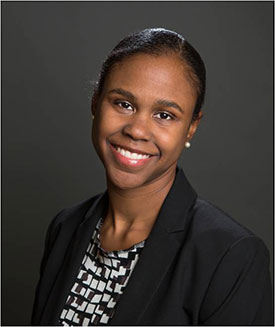
Epidemiologist Tamara James-Todd spoke with Living on Earth about her research on the harmful effects of hair products on Black women’s health. (Photo: Harvard T.H. Chan School of Public Health)
CURWOOD: Wait. So, what's in the stuff that's going on one's body is not on the label?
JAMES-TODD: Correct, and so, of concern, of course, is that then we're completely relying on the companies to test for the safety of our products. And it doesn't take a lot of thought, but that seems like a conflict of interest. The company is trying to make a profit. You know, right now, there is some legislation under way and being developed; the Personal Care Product and Safety Act is being developed by Senators Feinstein and Collins to really, kind of, rethink the protocol and the process by which chemicals and ingredients are tested before they make it to our shelves. Because the average consumer thinks that if it's on the shelf, it's safe.
CURWOOD: In the meantime, what's someone to do who says, OMG, this stuff could give me cancer or make me overweight, all kinds of not fun things. How can someone find safe hair care products?
JAMES-TODD: There is a growing amount of information out there around fragrance and considering going fragrance-free. So, that might be a strategy that one takes, maybe reducing the amount of synthetic chemicals that are being used. There's a kind of movement towards “do it yourself,” and then also, I think, you know, it's cultural change. So, we started with this idea of standard of beauty, and it’s, in my opinion, beautiful to see people starting to embrace more natural hair styles which require less chemical exposure. Certainly people are still using some of these other products daily, but the fewer chemicals that one might be using may be helpful.
CURWOOD: How affordable are paraben-free, phthalate-free alternatives to mainstream hair products for black women?
JAMES-TODD: So, I think the bigger question around that is, are they even on the market? There's very limited selection of those products on the market, and where they do exist they are often not necessarily in kind of traditional stores, and are often more expensive. So, in that case, I think that there needs to be more products introduced on the market, with recognition that these products are important to African-American women and that they do have purchasing power. This is a very large industry.
CURWOOD: We've been talking about women here, but of course, men use these hair care products. What risks do black men, do men of color, run when it comes to hair care products?
JAMES-TODD: It's funny you should ask that. One of the issues that came up when we were doing the Greater New York Hair Products Study that we did back in the early 2000s was that we were just collecting data on women. And one of our largest catchment areas when we were doing recruitment was at churches, and so we would go in and make our little pitch and I'll never forget, one gentleman and his son stood up and said, "What about us? We use hair products as well!" And I said, “Well, we're not really studying you right now." We were interested in breast cancer at the time which was part of the reason why we weren't studying men -- not that men can't have breast cancer! -- but it was one of those things where it was kind of an “ah-ha” moment and so the reality is that black men are using these products too. Oftentimes they wear shorter hair styles and so if you think about it, the application of some of these products is that much more close to the scalp and absorbed through the scalp, and, you know, could have some similar health implications for diseases that are linked to some of these endocrine-disrupting chemicals.
CURWOOD: Talk to me about your own hairstyle, Dr. James-Todd, and what you use and what advice based on your own experience -- just anecdotally -- what advice you would make based on that experience.
JAMES-TODD: So, I remember when I was probably about eight or nine years old, and my mom took me to that, you know, beauty salon and I very much remember one of my first visits there. And again this is at a time period and an era where straight hair was what was acceptable, and so I had a perm done. And all my hair fell out. [LAUGHS] And I was done. I didn't want to do that anymore, and so I have been natural since the late 80s. And I remember that that was at a time where my grandmother, who was born in Tennessee, did not think that was acceptable at all. And I like my curly hair, and so it's been interesting to watch this transition happen before my eyes. I went to school in the south, too, I went to Vanderbilt University, and I remember many of the other black women thinking, like, why would she wear her hair like that, or thinking I was from a different country, because if I was American, I would not wear my hair this way. And it's been beautiful to see people embracing their hair. I am fragrance-free. I've been using the same product now for the past 30-plus years. Thank goodness it's still on the market! [LAUGHS] But, you know, I have a daughter as well and I use that same product on her. I think that minimizing -- again, my philosophy is if I can minimize the amount of products and maintain natural hair that's healthy, then that's good enough for me. As far as advocating for other women, I understand that some people don't feel as comfortable, you know, doing that, or they think that it'll affect their job or other issues. But I think as society changes its standards of beauty, it's been nice to see that being embraced.
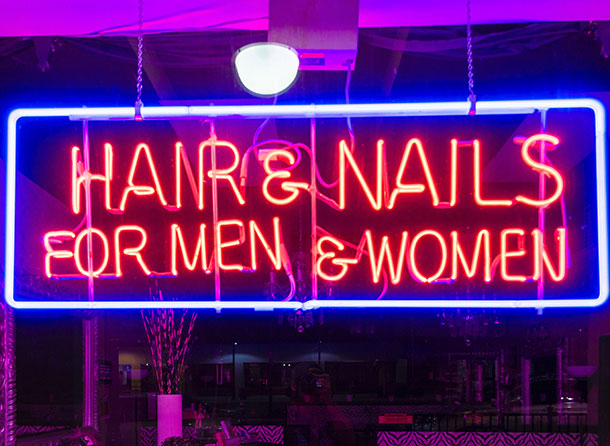
For many in the black community, hair care is a process that may involve different products like leave-in conditioners, root stimulators and anti-frizz polishers – but it’s also an important community activity. (Photo: Andrew Ruiz, Unsplash)
CURWOOD: Now people can go on our website to see your beautiful hair, but if they can't, it's lustrous, shiny, pulled back in a bun in the back. You must use a fair amount of oil.
JAMES-TODD: So, I do use this, it’s really a leave-in conditioner, and water. [LAUGHS] So, that's about it for me. But I do recognize that that's not what everyone else could do.
CURWOOD: [LAUGHS] Dr. Tamarra James-Todd is an epidemiologist with the Harvard T.H. Chan School of Public Health. Thanks so much for taking the time with us today.
JAMES-TODD: Thank you.
Related links:
- The Greater New York Hair Care Products Study
- About the Silent Spring Institute study
- More on Tamarra James-Todd
- More about Change-maker Madame C.J. Walker
[MUSIC: Poncho Sanchez, “Afro-Cuban Fantasy”]
CURWOOD: Coming up -- “The greatest two-fer of our lives” -- how tackling climate change improves public health. That’s just ahead here on Living on Earth. Stay tuned.
You can hear our program anytime on our website or get an audio download. The address is LOE dot ORG. That's LOE dot org. There you’ll also find pictures and more information about our stories. And we’d like to hear from you: You can reach us at comments @ l-o-e dot org.
Once again, comments @ l-o-e dot org. Or if you prefer to use a stamp, the postal address is PO Box 990007, Boston, Massachusetts, 02199. And you can call our listener line, at 617-287-4121. That's 617-287-4121.
ANNOUNCER: Funding for Living on Earth comes from you our listeners, and United Technologies -- combining passion for science with engineering to create solutions designed for sustainability in aerospace, building industries and food refrigeration. UTC companies such as Otis, Carrier, Pratt & Whitney and UTC Aerospace Systems are helping to move the world forward. You can learn more about United Technologies by tuning in to the Race to 9 Billion podcast. Listen at raceto9billion.com. That’s raceto9billion.com. This is PRI, Public Radio International.
[CUTAWAY MUSIC]
Former EPA Chief Gina McCarthy Launches Center for Climate, Health and the Environment At Harvard
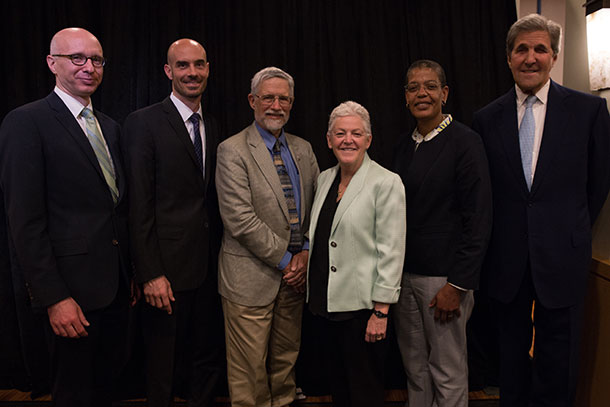
From left: Aaron Bernstein, Joseph Allen, John Holdren, Gina McCarthy, Michelle Williams, and John Kerry. All spoke at the launch of C-CHANGE, the Harvard Center for Climate, Health, and the Global Environment. (Photo: Courtesy of Sarah Sholes and the Harvard T.H. Chan School of Public Health)
CURWOOD: It’s Living on Earth, I’m Steve Curwood. The Harvard T.H. Chan School of Public Health has just unveiled a new initiative, C-CHANGE. That’s the letter C and change. Dean Michelle Williams recruited former EPA Administrator Gina McCarthy to take a departmental initiative school-wide.
[AUDIENCE CHATTER]
BERNSTEIN: My name is Ari Bernstein. I’m delighted to welcome you to the launch of the Center for Climate, Health, and the Global Environment at the Harvard T.H. Chan School of Public Health.
[APPLAUSE, CHEERS]
CURWOOD: Pediatrician Ari Bernstein is the co-director of the new center, and, as he welcomed the crowd, he highlighted core problems they plan to tackle.
BERNSTEIN: The first is the toxification of our planet, with pollution of air, fresh water and oceans at levels today that are unprecedented around the world. The second is climate change, which despite having been identified as the greatest health threat to humanity in the century, too few people realize its importance to their own health.
CURWOOD: The C-Change launch reunited some veterans of President Obama’s environment team, including former Presidential Science advisor and Harvard Professor John Holdren.
HOLDREN: Climate is the envelope within which all other environmental conditions and processes that affect our well-being must function.
CURWOOD: Professor Holdren says science explains how disrupting the climate leads to heatwaves, to wildfires, to floods, to sea level rise. Yet he notes the Trump White House still has no science advisor or council on science and technology.
HOLDREN: Something that President Obama understood very clearly and it appears President Trump does not understand so clearly is that science is crucial to moving the needle on virtually every national priority on the list. C-CHANGE is going to be in the business of keeping science and scientists relevant. I think nothing could be more important than that.
CURWOOD: Former Secretary of State John Kerry, a chief architect of the Paris Climate Agreement and another member of the Obama green team, took the occasion to sound an alarm.
KERRY: I find it…it’s not just incredible, it’s near criminal in the level of negligence that it represents which is to have a president of the United States who literally discards, disavows, and shows a complete disinterest in facts and in science and pulling out of the Paris Agreement is contrary to every fact. So, to have a president and an EPA director who are not just avoiding the realities of climate but who are avoiding all sense of responsibility to the future is beyond stunning. Lives will be lost!
CURWOOD: And former EPA head Gina McCarthy believes that in tackling the health problems related to climate change, C-CHANGE will build from Harvard’s legacy of life-saving research.
MCCARTHY: Pollution keeps people down. Clean healthy lives raises people up, it gives them a voice in their own future. That’s what science can do, that’s what our work is going to try to support. Thank you very much.
[APPLAUSE]
MCCARTHY: This is wicked fun, isn’t it? I love launches! Where’s the champagne?
[APPLAUSE, AUDIENCE LAUGHTER]
CURWOOD: We didn’t have any champagne when we pulled Gina McCarthy aside.
CURWOOD: So, what's your new title? Are you Professor, or are you Administrator, or are you Madam? What do I call you?
MCCARTHY: [LAUGHS] Gina would be best, but I am a full-time professor here at Harvard, and I'm also the director of a new center that we’re launching today called the Harvard Center for Climate, Health, and the Global Environment. We thought it was important to recognize at the School of Public Health that climate change is the biggest public health challenge that we face, and we wanted to put a different spin and face on climate change and its connection to public health. We need people to understand that climate change impacts them, their families, their kids' future. But also we thought that with so much resources that are going to have to be directed towards addressing climate change, why not try to not just fix the planet in the future, but let's fix public health today. We have some real challenges, and if you bring climate change down to size, it's nothing but carbon pollution. This school has attacked pollution for decades, identified it as a public health problem, helped design solutions. That's what we need to bring to the table today. Let's connect the dots. Let's make it manageable. Let's not scare people. Let's actually use this as an investment opportunity to do both. It's a great two-fer. My mother woulda loved it.
CURWOOD: So, what do you do on Day One to bring people in?
MCCARTHY: Well, we are doing a number of things. One is we're doing obviously outreach now. The center has had a great amount of people that have invested and done work in it. We're trying to extend the opportunity for this to be a school-wide center, so it's not just about environmental health challenges. It's about the full range of public health impacts that this school looks at, everything from not just air pollution but communicable disease, infectious diseases, population issues, how you build buildings and make them safe and clean. It's about nutrition and what does that mean for a low carbon future, where are we going to get our protein, how are you gonna grow it? And the whole role of the center is to really make that science actionable and bring it to people who can do something with it.
CURWOOD: OK, so how do you cut through the fog? What do you want to do with kids?
MCCARTHY: You know, kids are very special little creatures. They are absolutely more vulnerable to all sources of pollution because their bodies behave differently. So, one of the tasks is to understand how do we reduce air pollution and reduce the impacts of climate in ways that are going to keep our kids healthy today and also advance our interest in stabilizing the planet.
CURWOOD: How do you drive a research effort in this area? You know, folks in the academy tend to… well, they want to study what they want to study.
MCCARTHY: One of the ways in which the center can work is to sit down with the scientists and identify what they're learning, and we can do indirect focus research as well, to make sure that it is absolutely on target. You know, scientists went into this business because they cared about public health, not just as an intellectual exercise, which is why I'm here. None of this is going to be about pie-in-the-sky ideas. It is going to be, what do we know, how do we get that information out to the public, they can make choices themselves, and also get it to other decision-makers. Because, Steve, you and I know there's ebbs and flows at the federal level. We're at one of the biggest ebbs that I think I've ever seen, but I do think that people can step up and want to step up. We're seeing it in states. We're seeing it in cities. We're seeing it in the private sector. And if that's where the action is, then I'm sitting in a pretty sweet spot right now.
CURWOOD: If there was one research project that you could see get going around healthy kids and the question of climate change, what would be the one that you would want to start right now?
MCCARTHY: Actually there is some associations that are being seen in the research community between exposures to particulate matter, the small particulate matter in the air right now, that looks like it's impacting the neurological systems of our kids as well as our adults. So, there are hints that there's a connection between autism and dementia, and exposure to significant levels of air pollution. I think we deserve to bring that to ground. We're beginning to see that there are actually changes in the fetus when the mother is exposed to air pollution, changes that result in higher blood pressure for kids when they’re born. These are big-deal issues, and I don't need government to translate that for normal human beings.
CURWOOD: And of course, those particulates get belched out of the smoke stacks of coal-fired power plants, out of the tailpipes of diesel and other fossil-fuel vehicles. So, there are multipliers there. So, better fuel economy would make for smarter Americans?
MCCARTHY: [LAUGHS] That's a really good way of tying some dots. You know, I think my argument would be that if you look at climate change through the lens of public health, then you can identify significant opportunities to make the world a healthier place, to protect our kids' health today while we look at how we create a more sustainable and just future. Steve, the information that I'm reading -- and it's nice to not just have to read rules all the time, frankly! -- but the stuff that I'm reading is really telling me that we are facing like nine million people across the world every year dying from exposure to traditional pollutants, and that's just the handful that we can quantify. So you have 1.1 million people that are estimated to die every year in New Delhi prematurely, because of air pollution. Now, if we want India to participate in climate change actions, why wouldn't we tell them to look at the sources that are impacting those 1.1 million people? Because if you do, you'll see that the sources are the coal-fired power plants and the old primitive cookstoves, which are burning coal and dung and other things that are available. And you would focus your attention there, which is the biggest two-fer of our lives, right? I can actually show India that by being a good world citizen in correcting a problem that they think pretty much the developed world has created -- which they're not wrong about -- and I can tell them how to get there in ways that make their communities healthier, that lift their people out of poverty, that give them a voice. That's how democracy will be secured. That's how national security will be secured. That is a future that we can grab today.
CURWOOD: Indeed. Talk to me about what you want to do around buildings.
MCCARTHY: Well, I think we all know that there has been a movement called the green buildings, which has been a great movement. It's an opportunity to recognize that buildings contribute somewhere in the vicinity of 30 percent of the greenhouse gases, are actually being generated by energy that is used in buildings. And so there's been a great movement to make them tighter, to make them more efficient, to think about how we can adjust to a very urbanized area which is what the world is going into. But what -- the dimension we want to add to that is a healthy buildings dimension. If you're going to go green, what you're gonna have to recognize is, you better take care of the indoor air quality, or you are going to simply make people sick while you make those buildings green. Nobody wants that, and there are tremendous opportunities today. We already know that indoor air is a challenge, but we know that there's monitoring that can speak to your HVAC system that can make that air flow where it's needed, when it's needed. We are tracking what that means not just for the health of the people in it, but -- and this is important, Steve -- but their productivity. So, if I really want to make the case for businesses everywhere to start looking, not just at greening their buildings but making them more healthy, we can turn that into an investment for them, not a cost. That's what we have to do with everything. We've succeeded in the clean energy market in the United States. It's taken off like crazy because clean energy is cheaper, and it's smarter, it's in the market, it's built into the system. That's what we need to do with buildings too.
CURWOOD: So, what about healthy cities and climate? This is an initiative you have with your center.
MCCARTHY: Yeah, well, this is a really a great initiative because it's focused on cities where most of the action is these days. Mayors are stepping up, they're making commitments. They want the international community to know that we’re all still in. So, it's great to have California, it's great to have RGGI here in the Northeast and Mid-Atlantic, but we need that action to be spread all over. That's where mayors come in. They can't hide from the challenge of climate change, and they’re not. One of the things they're beginning to do is to make commitments to mitigate climate, not just commitments to adapt and invest in resilient cities. And so we want to work with them because we have ways -- for example, they're investing pretty heavily in electric buses, which is great for the transportation sector, but it's also great if those buses go in the communities that are most vulnerable because they are already facing significant air pollution. So, why wouldn't you put those buses in those most vulnerable communities, so that a mayor can make an announcement that's not just, I'm spending taxpayer dollars for the future. He can say, I'm investing in the communities today that need those air pollution reductions the most.
CURWOOD: So, let's look ahead to the Paris Climate Agreement. There's another big session coming up this year in December in Poland. What will you be saying there? You have an opportunity to talk to the world about these initiatives there.
MCCARTHY: I think I want to tell people that the U.S. is still in. Secondly, that the work that we’re doing today, it provides opportunities for solutions to climate change that can improve their lives, that can help them build a stronger economy. It's unacceptable and it's not just to have that many millions of people in poverty, particularly the most heavily hit -- which are the most vulnerable and disenfranchised -- not being considered as a central component of a sustainable development strategy, and I think we owe it to the world and I think we benefit every time another country gets healthier.
CURWOOD: So, at Harvard, you are launching this Center for Climate Health and the Global Environment, really re-versioning something that's been going on for a number of years. And it seems like you've gotten the old gang together. You have President Obama's former science advisor John Holdren, you have his Secretary of State John Kerry, who was such a leader in the whole Paris process, and you have, uh, what's her name? Gina McCarthy, ran the EPA?
MCCARTHY: Yes, she did. Really well, I might add. [LAUGHS]
CURWOOD: So, government in exile here?
MCCARTHY: You know, one of the things that was most ingenious about the strategy that President Obama took on climate change was that for the first time -- and I've been working on climate change for a long time at the state level -- for the first time, climate change was seen as more than just the planet is unhealthy. It was more than just focusing on polar bears.
CURWOOD: I don't see polar bears on your literature here.
MCCARTHY: Well, we do love them but they're invested in elsewhere. But he really made it the case that he needed his entire administration to work together because climate change impacted everything. It impacted our public health, our national security, our economic growth. He saw it as both a challenge and an opportunity. I'm going to keep that attitude, and I think I worked with John Holdren because he was the president's main science advisor in the White House. I worked with John Kerry because he's been focused on these issues for so long, and what we knew was that the U.S. had to deliver really strong actions on climate, which we succeeded at doing at EPA because of the great people there. And we knew that John Kerry could carry that with the president and turn it into an international agreement. And we were extraordinarily proud of that, and I want that pride to continue. I want the people to understand that this is not about what's happening in Washington. It's about real life, real people, our kids' future. If we can get that message, if we can keep optimistic, then I think that we can make some terrific reductions in the kind of pollution that's impacting our lives today and our future tomorrow.
CURWOOD: Gina McCarthy is the former EPA administrator and now leads the Center for Climate, Health, and the Global Environment at the Harvard T.H. Chan School of Public Health. Professor, thanks for taking the time with us today.
MCCARTHY: Wonderful to talk to you again, Steve. Thanks.
Related links:
- C-CHANGE: Center for Climate, Health, and the Global Environment
- Boston Globe: Gina McCarthy’s Take on Climate Change
- The Harvard Healthy Buildings Initiative
[MUSIC:" Celso Fonseca, “Por acaso pela tarde”]
CURWOOD: Living on Earth is produced by the World Media Foundation. Our crew includes Naomi Arenberg, Bobby Bascomb, Thurston Briscoe, Savannah Christiansen, Jenni Doering, Jaime Kaiser, Hannah Loss, Don Lyman, Helen Palmer, Aynsley O’Neill, Adelaide Chen, and Jolanda Omari. Tom Tiger engineered our show, with help from Jeff Wade and Jake Rego. And we welcome new interns -- Maggie O’Brien, Sarah Rappaport and Anna Gibbs. Alison Lirish Dean composed our themes. You can hear us anytime at L-O-E dot org - and like us, please, on our Facebook page -- PRI’s Living on Earth. And we tweet from @livingonearth. I’m Steve Curwood. Thanks for listening!
ANNOUNCER 1: Funding for Living on Earth comes from you our listeners, and from the University of Massachusetts, Boston, in association with its School for the Environment, developing the next generation of environmental leaders. And from the Grantham Foundation for the protection of the environment, supporting strategic communications and collaboration in solving the world’s most pressing environmental problems. Support also comes from the Energy Foundation, serving the public interest by helping to build a strong, clean, energy economy; from Carl and Judy Ferenbach of Boston, Massachusetts; and from SolarCity, America’s solar power provider. SolarCity is dedicated to revolutionizing the way energy is delivered by giving customers a renewable alternative to fossil fuels. Information at 888-997-1703. That’s 888-997-1703.
ANNOUNCER 2: PRI, Public Radio International.
Living on Earth wants to hear from you!
Living on Earth
62 Calef Highway, Suite 212
Lee, NH 03861
Telephone: 617-287-4121
E-mail: comments@loe.org
Newsletter [Click here]
Donate to Living on Earth!
Living on Earth is an independent media program and relies entirely on contributions from listeners and institutions supporting public service. Please donate now to preserve an independent environmental voice.
NewsletterLiving on Earth offers a weekly delivery of the show's rundown to your mailbox. Sign up for our newsletter today!
 Sailors For The Sea: Be the change you want to sea.
Sailors For The Sea: Be the change you want to sea.
 The Grantham Foundation for the Protection of the Environment: Committed to protecting and improving the health of the global environment.
The Grantham Foundation for the Protection of the Environment: Committed to protecting and improving the health of the global environment.
 Contribute to Living on Earth and receive, as our gift to you, an archival print of one of Mark Seth Lender's extraordinary wildlife photographs. Follow the link to see Mark's current collection of photographs.
Contribute to Living on Earth and receive, as our gift to you, an archival print of one of Mark Seth Lender's extraordinary wildlife photographs. Follow the link to see Mark's current collection of photographs.
 Buy a signed copy of Mark Seth Lender's book Smeagull the Seagull & support Living on Earth
Buy a signed copy of Mark Seth Lender's book Smeagull the Seagull & support Living on Earth

